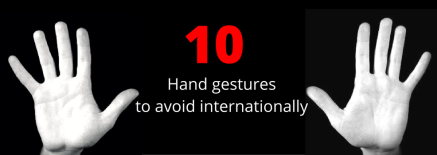Body language cheat sheet: 30 Tips for a successful presentation

When you give a presentation or talk in front of an audience, your body language will have a major influence on whether or not your message is received. Body language can affect whether the audience believes you are credible, whether your message is valuable and interesting, and whether they should take stock of what you are saying and get on board with your ideas.
Albert Mehrabian, Professor Emeritus of Psychology at UCLA, is a global expert on the importance of verbal and nonverbal messages. His findings confirm that our body language must be congruent with our message because our words convey only 7% of the meaning, our vocal expression 38% and our body language a whopping 55% of what the audience will remember and believe about you as a speaker.
Even if your content is invaluable, the message your body is delivering will be the deciding factor to whether your audience will engage with you.
We’ve narrowed down hundreds of ideas to the top 30 body language tips to use during your next presentation. These tips range from how to draw on your natural charisma to how to get the audience pays attention to your key points. But before we get to all 30 tips, here is a cheat sheet that will make it easy to make a good impression.
Body Language Cheat Sheet
To make this even easier, here is a cheat sheet with all of the best body language tips for impactful presentations.

You may be also interested in
Reading time:2 min reads
Reading time:3 min reads
Top 30 Body Language Tips for Great Presentations
-
You have seven seconds. Studies found that first impressions matter a lot, people will have largely formed their opinion about you based on the first several seconds of watching your talk, so make sure your intro counts.
-
Tap into your emotions. True engagement requires a level of emotional involvement, and the best way to cultivate this is to focus on your own emotions. Before your get on stage, ask yourself how you feel about your message. What do you want the audience to feel? By focusing intensely on what you are feeling, your body language will automatically convey it to the audience.
-
Loosen your shoulders. Keep your back straight but not rigid, and shoulders relaxed. When you are nervous or tense, it usually shows up in your shoulders, which will move up, in and forward. Loosen them up by giving them a small shake, and pulling them down and back.
-
Keep your arms relaxed at your sides. Your arms are a great indicator as to whether you are an open and trustworthy person, or whether you are insecure or hiding something. Keep your arms uncrossed and avoid standing with your hands on your hips, hiding your arms behind your back, or clutching your hands up by your chest: as these actions can subconsciously alarm your audience.
-
Use your hands to gesture when you speak. Proper gestures improve your credibility with the audience, while improving your thought process. Your hands can be used to describe something or to add weight to a point you are trying to make. Be cautious about going overboard because it might become distracting.
-
Balance out good eye contact. Eye contact communicates sincerity and credibility. Avoiding eye-contact might make you seem insecure or untrustworthy. Effective speakers engage one person at a time, focusing long enough to complete a sentence, before moving to a different person, or in case of large audiences, sections of the crowd in front of you. This being said, don’t stare, as maintaining too much eye-contact might make people uncomfortable, generally around 4 to 5 seconds is perfect.
-
Monitor your voice. Keep your voice at an even level, and don’t let your tones spike too high. By taking a deep breath and speaking slowly and clearly, you will give the impression that you are relaxed and confident: things which will keep your audience engaged.
-
Smile often and laugh occasionally. Smiling and laughter will put your audience at ease: people will be more inclined to listen to you if you seem to be a positive person. There is a fine balance between seeming positive and going overboard, laughing too much will it make you seem nervous and needy, while keeping a smile plastered on your face will make you seem insincere. Keep it simple: relaxed and happy.
-
Avoid fidgeting. It might make you seem nervous and can be distracting for the listeners. Avoid fidgety movements such as tapping your foot, clicking a marker lid, or drumming your fingers against the podium. You’ll seem nervous and it will distract your audience. Slow down and keep your movements focused.
-
Keep your eyes on the audience. It can be tempting when you get on stage to keep your eyes trained on the ground or to focus solely on your slides, but this might make you seem like you don’t really know what you are doing. Keep your head up straight, and your eyes towards the audience.
-
Slow down. Speaking and walking slower not only makes you seem more calm and confident, it will also help you feel less nervous.
-
Keep your neck straight. While standing with a straight back is part of good posture, it’s important to remember to include your neck- don’t let it stoop forward, as this will block your voice, and make it more challenging to maintain great eye contact with the audience. Keep your whole spine straight and aligned.
-
Make a great entrance. Even if you’ve received an amazing an introduction, your audience might not be ready to start. Their thoughts are still with the person who introduced you, the message they just recieved on their smartphone, or the remark their colleague sitting next to them just made. To be sure your listeners are receptive by walking to center stage and looking at the audience silently for a moment. Smile and nod slightly. Once you feel the audience's attention building, it is the perfect time to start speaking.
-
Keep your words and your facial expression consistent. Inconsistency causes people to sense that something isn't quite right. They might even begin to suspect that you're trying to deceive them, or that you have no idea what you are talking about. Be conscious about the consistency between your expressions and words.
-
Avoid exaggerated body language. Not only will it seem disingenuous, but can be interpreted as neediness. For example, people may perceive very heavy nodding as an attempt to show you agree with or understand something that you actually don't.
-
Working with objects. Whenever you are dealing with props or technology in a talk, from a remote clicker to a flip chart marker, make sure you know what your are doing and that it works! You can easily derail your talk with a malfunction. When you are done using the object, put it to the side: it will reduce the temptation to continue playing with the object after it has served its use.
-
Amplifying your most important points with gestures. Make your actions appropriate to what you’re saying. Audiences are drawn to movement and you can easily emphasize a point with the right gestures.
-
Take center stage. Stand front and center on the stage, where everyone in the audience can see you. That spot should be your main position. However you are not locked there, move away from time to time for emphasis or to change direction in your speech. Remember to go back to center stage so the entire audience can see you the majority of the time.
-
Command the stage by trusting your content. Whatever the content of your message, your physical presence needs to match your material in terms of impact. Understand why you are up there and the story you want to tell: the beginning, middle and end. Confidence is key.
-
Move with purpose. If you move when you speak, you’ll keep the audience’s attention. Try moving toward the audience before making a key point, and away when you change subject. You can also use the stage to facilitate the movement of your ideas. For example, if you’re presenting three issues, talk about each of them from a different physical position. Make sure you are front and center stage when you are making your most important points. If the room is smaller and the audience is seated in a U-shape, feel free to walk “inside the bay” even if some participants will see only your back for a few moments - then make sure you walk back before the lack of eye contact becomes uncomfortable for anyone.
-
Don’t grip the podium or microphone stand. If you're using a podium or microphone stand, place your hands lightly on the top of it or in a relaxed hold, white knuckles will not instill confidence in your listeners and prevent you from using supporting gestures.
-
Stay steady. Avoid shifting from your weight from one foot to the other. Stand with your feet firmly planted on the floor, with your weight equally distributed on both feet.
-
Avoid physical blockages. Make sure you are not partially hidden behind a desk, podium or flipchart. If you are obscured behind something, it will be more difficult for the audience to focus on you and your message. If you must stand behind something, do so with assurance and not as if you are shrinking from the audience.
-
Be mindful of your blinking. Blinking too much is a sign you’re uncomfortable. Try to relax, and if you find yourself blinking excessively, close your eyes for just a second and opening them again slowly.
-
Dress for success. Adjust your clothing to set the tone. When it comes to sending signals through your body language, the way you dress can instantly send your audience a plethora of messages. If you are not certain of what the tone should be: find out from the organizer - you don’t want to come across as too stiff or too casual by overdressing or underdressing. Dressing is also affected by the genre of your talk: if you’re the keynote at a corporate event, this may require elegant outfit while being a trainer for a 2-day seminar may warrant a business casual dress.
-
Pay attention to your palms. Gestures with palms exposed show that you are open and expressive, while palms turned down indicate that you are decisive and feel strongly about what you are saying.
-
Scripts kill your charisma. Speakers who offer more vocal variety are not only more charismatic, but audience believe them to be more credible. When a talk is too scripted and perfected, audiences generally become bored quicker. Interestingly, even if you are delivering a webinar without video, audiences who only hear your voice can still tell if you are reading it from a paper or talk only on the basis of bullet points but adding your own words.
-
Widen your stance to sound dynamic. Your voice reverberates up from your entire body, not just your mouth. Open up your stance a little wider than hip distance. This will calm your nervous system, allows you to breathe with ease, and amplify your voice.
-
Facial expression. Expressions can build a connection with your audience, or undermine your every word. Avoid artificial, unfriendly, or deadpan expressions. Include facial expressions that support your stories and actually reflect your emotions.
-
Stay positive. Most importantly maintain an open and relaxed attitude. How you feel will come through in your body language, which will have the greatest impact on your talk.
Want to learn about how you can instantly start getting more speaking opportunities with SpeakerHub? Find out more about how SpeakerHub works, or contact us here.







